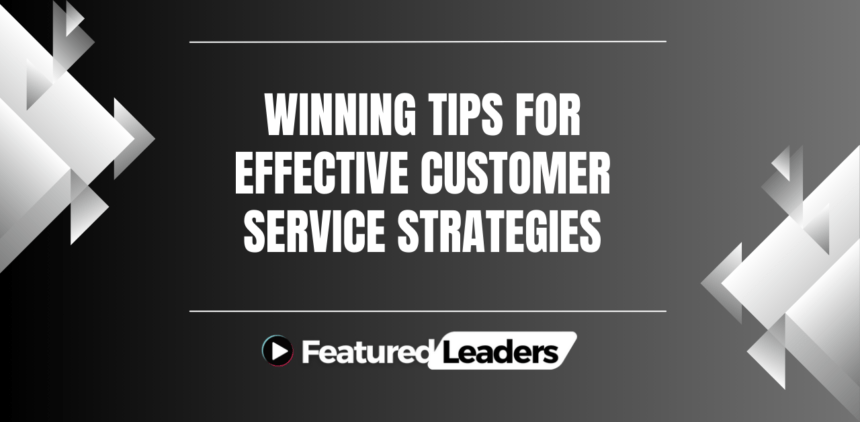A customer service strategy is vital for businesses to succeed in today’s competitive market. By implementing effective customer service strategies, businesses can enhance customer satisfaction, build strong relationships, and stand out from the competition. In this article, we will explore the key elements of an effective customer service strategy and provide tips on how to create a memorable customer experience.

Key Takeaways:
- Define clear goals for your customer service strategy, such as improving customer satisfaction and loyalty.
- Identify all customer touchpoints to gain insights into the customer journey and enhance the overall experience.
- Set SMART goals that are specific, measurable, achievable, relevant, and time-bound.
- Identify key performance indicators (KPIs) to track and measure your customer service performance.
- Build a strong customer service team with the necessary skills and provide ongoing training and support.
By implementing these winning tips for effective customer service strategies, businesses can elevate their customer service game, achieve customer satisfaction, and drive long-term success.
Defining Goals
One of the first steps in creating an effective customer service strategy is to clearly define your goals. Without clearly outlined goals, it becomes challenging to measure the success of your customer service efforts.
When establishing your customer service strategy goals, it is important to include objectives related to customer satisfaction, loyalty, and overall experience. These goals will guide your customer service team in delivering exceptional service and ensure that your efforts align with your business objectives.
“By setting specific and measurable customer service goals, businesses can track their progress and make the necessary adjustments to improve customer satisfaction.”
Setting specific goals allows you to quantify your progress and measure customer satisfaction accurately. Your goals should be both achievable and relevant to your business’s unique needs. Additionally, it is crucial to set realistic timeframes for achieving these goals.
Examples of Customer Service Goals
Here are some examples of customer service goals that businesses commonly set:
- Improve customer satisfaction ratings by 10% within the next quarter.
- Increase customer loyalty by implementing a robust customer loyalty program.
- Reduce customer response time to inquiries by 20% in the next six months.
- Enhance overall customer experience by implementing a self-service portal.
By defining your customer service strategy goals, you create a clear roadmap for success. These goals help guide your customer service team’s actions, providing them with a sense of purpose and direction. It also allows you to assess your customer service performance, make data-driven decisions, and continuously improve your customer service strategy.
With defined goals in place, you can ensure that your customer service strategy is focused on achieving customer satisfaction, loyalty, and overall success.
Identifying Customer Touchpoints
To create an effective customer service strategy, businesses need to identify all customer touchpoints. These touchpoints are the various interactions that customers have with the business throughout their journey, from pre-purchase to post-purchase. By analyzing customer interactions across all touchpoints, businesses can gain insights into the customer journey, identify trends, recurring issues, and customer behaviors.
This information can be used to improve customer service, enhance products or services, reduce churn, and increase customer lifetime value. Understanding customer touchpoints helps businesses optimize the customer journey and deliver an exceptional customer experience at every stage.
Customer Journey Map
In order to identify customer touchpoints, businesses can create a customer journey map. This visual representation of the customer’s interactions and experiences allows businesses to visualize the entire customer journey and the touchpoints along the way. It provides a clear understanding of how customers engage with the business, where they encounter pain points or friction, and opportunities to enhance their experience.
Examples of Customer Touchpoints
Customer touchpoints can vary depending on the nature of the business and the industry. They can include both online and offline interactions. Here are some common examples of customer touchpoints:
- Website: Browsing products or services, reading informative articles, downloading resources
- Social media: Engaging with posts, comments, and direct messages
- Customer service hotline: Calling for assistance or inquiries
- Physical stores: Visiting a retail location, interacting with sales staff
- Email: Receiving marketing communications or transactional emails
- Mobile app: Using the app for purchases, tracking orders, or accessing exclusive content
- Live chat: Engaging with a customer support agent in real-time
- Product packaging: Unboxing experience and reading product information
- Post-purchase follow-up: Satisfaction surveys, feedback requests, or loyalty program updates
Using Customer Touchpoints to Improve Customer Service
By analyzing customer interactions at each touchpoint, businesses can identify areas for improvement and implement strategies to enhance the customer experience. It allows them to:
- Identify pain points: Understanding where customers encounter difficulties or frustrations helps businesses address these issues and deliver better solutions.
- Personalize interactions: Analyzing customer behaviors and preferences at different touchpoints enables businesses to tailor their interactions and provide a more personalized experience.
- Optimize communication channels: By identifying customers’ preferred communication channels, businesses can ensure they are delivering messages through the right channels at the right time.
- Measure customer satisfaction: By tracking customer interactions and sentiments across touchpoints, businesses can measure customer satisfaction and identify areas for improvement.
By leveraging customer touchpoint data, businesses can align their customer service efforts with customer expectations, ultimately driving customer loyalty and increasing customer lifetime value.
Setting SMART Goals
Once goals are defined, it is important to set SMART goals for the customer service strategy. SMART stands for Specific, Measurable, Achievable, Relevant, and Time-bound.
Setting SMART goals helps businesses stay focused and track their progress. Each goal should be:
- Specific: Clearly defined and focused on the desired outcome. For example, instead of setting a goal to “improve customer satisfaction,” a more specific goal would be to “increase customer satisfaction ratings by 10% within the next quarter.”
- Measurable: Setting goals that can be quantified allows businesses to track their progress and make data-driven decisions. Having measurable goals also provides a benchmark for success. For example, using customer satisfaction scores as a measurable goal allows businesses to gauge improvements over time.
- Achievable: Goals should be realistic and within reach. Setting goals that are too ambitious or unattainable can lead to demotivation and frustration. By setting achievable goals, businesses can maintain motivation and celebrate small wins along the way.
- Relevant: Goals should align with the business’s overall objectives and be relevant to the customer service strategy. It is important to ensure that each goal directly contributes to enhancing customer satisfaction and improving the customer experience.
- Time-bound: Goals should have a specific timeframe for completion. By setting deadlines, businesses create a sense of urgency and accountability. This helps prioritize tasks and allocate resources effectively.
By following the SMART framework, businesses can set goals that are specific, measurable, achievable, relevant, and time-bound. This approach allows for clear direction, progress tracking, and ensures that efforts are aligned with the overall customer service strategy, ultimately leading to improved customer satisfaction and business success.
Identifying KPIs
In order to track and improve customer service performance, businesses should identify key performance indicators (KPIs). These KPIs play a crucial role in measuring the success of customer service strategies and providing actionable insights for improvement.
There are three important customer service KPIs that every business should consider:
- Customer Satisfaction Score (CSAT): CSAT measures the level of customer satisfaction with a business’s product or service. It is usually obtained through post-interaction surveys, where customers rate their satisfaction on a scale. By tracking CSAT, businesses can gain valuable insights into customer satisfaction levels and identify areas for improvement.
- Net Promoter Score (NPS): NPS is a measure of customer loyalty and advocacy. It assesses the likelihood that a customer would recommend a business to others. NPS surveys typically ask customers to rate their likelihood to recommend on a scale. By tracking NPS, businesses can identify their most loyal customers and further engage them as advocates.
- Customer Effort Score (CES): CES measures the ease of customer interactions and the effort required to use a product or resolve an issue. It helps businesses understand how easy or difficult it is for customers to engage with their services. By tracking CES, businesses can identify pain points and streamline customer experiences, reducing friction and improving satisfaction.
These KPIs provide quantifiable metrics that allow businesses to benchmark their performance, identify areas for improvement, and make informed decisions to enhance customer service strategies. By tracking these KPIs, businesses can ensure they are meeting customer expectations, building loyalty, and driving growth.
Building a Strong Customer Service Team
A strong customer service team is crucial for delivering exceptional customer service. To ensure the best customer support experience, businesses should focus on hiring and developing professionals with the necessary customer support skills and the right mindset. Some key skills to look for in customer support professionals include:
- Empathy: The ability to understand and connect with customers’ emotions and experiences.
- Adaptability: Being able to quickly adjust to different customer needs and situations.
- Clear Communication: Effectively conveying information and resolving issues.
- Positive Attitude: Maintaining a friendly and helpful demeanor, even in challenging situations.
Building a strong customer service team also involves providing ongoing training and resources to enhance their skills and keep them aligned with the business’s customer-centric vision. Regular customer service training sessions can help professionals stay up-to-date with the latest industry trends, improve their problem-solving abilities, and provide a consistent customer service experience. By investing in the growth and development of the customer service team, businesses can ensure their customers receive the best support and assistance.
The Impact of a Strong Customer Service Team
A well-trained and motivated customer service team has a significant impact on a business’s success. When customers receive excellent support, they are more likely to have a positive perception of the brand, stay loyal, and recommend the business to others. A strong customer service team can also proactively identify opportunities for improvement, gather valuable customer feedback, and collaborate with other departments to enhance the overall customer experience. With a cohesive and skilled customer service team in place, businesses can build stronger customer relationships and create a competitive advantage.
Utilizing Customer Service Tools
To enhance customer service performance, businesses should leverage the right customer service tools. These tools play a crucial role in streamlining operations, improving efficiency, and delivering exceptional customer experiences. By utilizing customer service tools, businesses can provide seamless support, facilitate omnichannel interactions, and empower customers through self-service options.
Omnichannel Support
One of the key customer service tools is omnichannel support. This tool enables businesses to manage customer interactions across multiple channels, such as phone, email, and live chat. With omnichannel support, businesses can ensure consistency in customer communication and easily transition between channels, providing a seamless experience. Customers can reach out through their preferred channel and receive the same level of support, regardless of the channel chosen.
In addition to improving accessibility and convenience, omnichannel support allows businesses to capture a comprehensive view of customer interactions. This holistic understanding enables businesses to provide personalized assistance based on the customer’s history and preferences, leading to enhanced customer satisfaction and loyalty.
Self-Service Options
Another essential customer service tool is self-service options. Providing self-service options empowers customers to find answers to their questions independently, reducing the need for direct support interactions. Businesses can offer self-service options such as knowledge bases, FAQs, video tutorials, and interactive troubleshooting guides. These resources not only contribute to improved customer satisfaction but also help businesses scale their support operations by handling common inquiries through self-service channels.
Self-service options can be particularly beneficial for customers who prefer to solve their own problems or those who require immediate support outside regular business hours. By offering comprehensive self-service resources, businesses can save time for both their customers and support teams, resulting in improved efficiency and customer service performance.
| Benefits of Utilizing Customer Service Tools |
|---|
| Improved efficiency in handling customer interactions |
| Consistent and seamless customer support experience across channels |
| Enhanced customer satisfaction and loyalty |
| Easier scalability of support operations |
| Empowered customers to find answers independently |
By harnessing the power of customer service tools like omnichannel support and self-service options, businesses can transform their customer service operations. These tools enable businesses to provide exceptional support experiences, improve efficiency, and drive customer satisfaction and loyalty.

Implementing a Customer-First Mindset
A customer-first mindset is key to providing effective customer service. It’s important for all employees, not just frontline staff, to prioritize customer happiness and be committed to delivering exceptional customer service. When everyone within the organization works with the end customer in mind, it creates a customer-centric approach that leads to better customer care, improved solutions, and increased efficiency.
A customer-first mindset also helps break down silos within the organization, ensuring seamless communication and alignment across teams. By fostering a culture that values the customer, businesses can create a positive customer experience at every touchpoint.
To cultivate a customer-focused mindset, businesses should:
- Provide customer service training and ongoing education to all employees
- Encourage open and transparent communication channels
- Collect and learn from customer feedback to address pain points and enhance the customer experience
- Empower employees to make decisions that prioritize customer satisfaction
- Promote a customer-centric vision throughout the organization
With a customer-focused mindset, businesses can go above and beyond to meet customer expectations, build strong relationships, and achieve long-term success.
“The customer experience is the next competitive battleground.” – Jerry Gregoire
| Benefits of a Customer-First Mindset | Ways to Implement a Customer-Focused Mindset |
|---|---|
| 1. Increased customer satisfaction | 1. Provide customer service training to all employees |
| 2. Improved customer loyalty | 2. Encourage open and transparent communication channels |
| 3. Enhanced brand reputation | 3. Collect and learn from customer feedback |
| 4. Higher customer retention | 4. Empower employees to make customer-centric decisions |
| 5. Increased customer lifetime value | 5. Promote a customer-centric vision throughout the organization |
Monitoring Customer Interactions
Monitoring customer interactions, including customer feedback and social media mentions, plays a crucial role in understanding customer sentiment and improving customer service. By collecting customer feedback through surveys and other means, businesses can gain valuable insights into their customers’ experiences, preferences, and pain points. This feedback becomes a powerful tool for identifying areas of improvement and making data-driven decisions.
Moreover, social media platforms have become a key channel for customers to express their opinions, share experiences, and seek assistance. By monitoring social media and tracking customer conversations, businesses can proactively address concerns, answer inquiries, and engage with their audience in real-time. This allows businesses to promptly resolve issues and demonstrate their commitment to customer satisfaction.
Importance of Customer Feedback
Customer feedback is a valuable source of information that provides businesses with insights into their customers’ sentiments, preferences, and expectations. By actively collecting and analyzing customer feedback, companies can:
- Gain insights into customer experiences and satisfaction levels
- Identify areas for improvement and address customer pain points
- Make informed business decisions based on customer preferences
- Enhance products, services, and overall customer experience
Customer feedback is not only limited to surveys; it can also be gathered through various channels such as customer support calls, emails, and live chats. Leveraging customer feedback helps businesses align their strategies and offerings with customer expectations, ultimately leading to greater customer satisfaction and loyalty.
Harnessing Social Media Monitoring
With the widespread use of social media platforms, customers are increasingly vocal about their experiences and opinions online. By closely monitoring social media platforms, businesses can:
- Track customer sentiments and identify emerging trends
- Respond promptly to customer inquiries, comments, and concerns
- Build brand reputation by being proactive and transparent
- Identify potential brand advocates and engage with influencers
It is essential for businesses to stay active on social media platforms, respond timely to customer interactions, and maintain a positive brand image. By using social media monitoring tools, businesses can efficiently manage customer interactions, improve response times, and ensure customer satisfaction.

Proactive Customer Service
Proactive customer service goes beyond reactive responses to customer inquiries and issues. It involves anticipating customer needs and providing personalized interactions to enhance their experience. By analyzing customer behavior and data, businesses can identify potential pain points or areas of improvement and address them proactively.
For example, a clothing retailer may use data analysis to identify popular styles or trends among their customer base. Based on this information, they can reach out to customers with personalized recommendations or offers, anticipating their fashion preferences and providing a tailored shopping experience.
This proactive approach also involves addressing potential concerns before they become problems. For instance, a software company can detect patterns in customer support tickets and proactively release updates or fixes to address recurring issues, minimizing customer frustration.
Another aspect of proactive customer service is continuously improving products or services based on customer feedback. By listening to customer suggestions and opinions, businesses can make enhancements that align with customer needs and preferences, further enhancing the overall customer experience.
By implementing proactive customer service strategies, businesses not only meet customer expectations but exceed them. This builds trust, fosters customer loyalty, and strengthens brand reputation.
Consider the following benefits of proactive customer service:
- Increased customer satisfaction by addressing needs before they arise
- Improved customer retention and loyalty
- Enhanced brand reputation through personalized interactions
- Reduced customer complaints and negative feedback
Proactive customer service is an essential component of a successful customer service strategy. By anticipating customer needs and providing personalized interactions, businesses can create a positive and memorable customer experience.
Continuous Improvement and Feedback
Continuous improvement is an integral part of maintaining effective customer service. Businesses must constantly strive to enhance their customer service performance by collecting valuable customer feedback, analyzing performance metrics, and making data-driven decisions to identify areas for improvement.
At XYZ Company, we understand that customer feedback is invaluable in shaping our customer service strategy and driving continuous improvement. By actively seeking feedback from our customers, we can gain valuable insights into their experiences and needs, allowing us to continually refine our processes and deliver exceptional service.
One effective way to collect customer feedback is through surveys and feedback forms. By providing customers with an opportunity to share their thoughts and opinions, we can identify potential pain points, areas of dissatisfaction, and opportunities to exceed expectations.
Not only do we collect feedback from customers who have directly interacted with our customer service team, but we also monitor online reviews and social media mentions to gain a holistic understanding of our customers’ experiences and perceptions.
Once customer feedback is gathered, it is crucial to analyze the data and metrics to uncover trends, patterns, and areas that require improvement. This analysis allows us to identify common issues, highlight areas of strength, and make informed decisions to enhance our customer service performance.
By leveraging customer service performance metrics such as customer satisfaction scores, response times, and first contact resolution rates, we can measure our success and identify opportunities for growth.
Implementing a feedback-driven approach ensures that we are continuously evolving and adapting to meet the changing needs and expectations of our customers. At XYZ Company, we value our customers’ input and strive to turn feedback into actionable insights that drive continuous improvement in our customer service performance.
Customer Feedback Loop
A crucial aspect of continuous improvement in customer service is closing the feedback loop with customers. This means acknowledging and responding to customer feedback, demonstrating our commitment to their satisfaction, and fostering a customer-centric culture within our organization.
By actively engaging with customers, we can address their concerns, resolve any issues, and provide personalized solutions. This not only enhances customer satisfaction but also builds trust and loyalty.
Additionally, engaging in ongoing dialogue with customers allows us to proactively identify emerging trends and potential service gaps. By anticipating and addressing customer needs before they become problems, we strengthen the overall customer experience and demonstrate our dedication to continuous improvement.
Benefits of Continuous Improvement and Feedback
The benefits of continuous improvement and a customer-centric feedback loop are far-reaching. By prioritizing these practices, businesses can:
- Optimize customer satisfaction and retention
- Enhance brand reputation and credibility
- Identify and address areas of improvement
- Drive innovation and competitiveness
- Increase customer loyalty and advocacy
At XYZ Company, we are dedicated to the continuous improvement of our customer service performance. By actively seeking customer feedback, analyzing performance metrics, and implementing the necessary changes, we ensure that our customers receive the exceptional service they deserve.
| Key Benefits of Continuous Improvement and Feedback |
|---|
| Optimizes customer satisfaction and retention |
| Enhances brand reputation and credibility |
| Identifies and addresses areas of improvement |
| Drives innovation and competitiveness |
| Increases customer loyalty and advocacy |
Conclusion
Implementing effective customer service strategies is crucial for businesses to achieve success in today’s competitive market. By prioritizing the needs and satisfaction of customers, businesses can build strong relationships, foster loyalty, and differentiate themselves from their competitors.
Throughout this article, we have explored various tips and best practices for creating a customer service strategy that delivers exceptional results. By defining clear goals, identifying customer touchpoints, setting SMART goals, and tracking key performance indicators, businesses can continuously improve their customer service performance.
Building a strong customer service team with the right skills, providing them with ongoing training and leveraging the right tools, businesses can enhance efficiency and deliver personalized experiences to each customer. Adopting a customer-first mindset and actively monitoring customer interactions and feedback enable businesses to anticipate needs, address pain points, and proactively resolve issues.
Continuous improvement is crucial for maintaining effective customer service. By actively seeking feedback, analyzing performance metrics, and making data-driven decisions, businesses can stay ahead of customer expectations and create a customer-centric culture that drives success.
FAQ
What is a customer service strategy?
A customer service strategy is a thorough plan to handle customer interactions and provide a consistent customer experience using set methods and processes.
Why is it important for businesses to have a customer service strategy?
Having a customer service strategy in place is essential for businesses to build superior customer relationships, satisfaction, and trust. Implementing effective customer service strategies can also help businesses win 91% of repeat customers.
What is the first step in creating an effective customer service strategy?
The first step is defining goals. Businesses need to clearly outline what they want to achieve with their customer service efforts, such as goals related to customer satisfaction, customer loyalty, and overall customer experience.
How can businesses improve customer service performance?
Businesses can improve customer service performance by setting SMART goals, identifying key performance indicators (KPIs), building a strong customer service team, utilizing customer service tools, implementing a customer-first mindset, monitoring customer interactions, providing proactive customer service, and continuously seeking feedback for continuous improvement.
What are key performance indicators (KPIs) in customer service?
Key performance indicators (KPIs) in customer service can include customer satisfaction score (CSAT), net promoter score (NPS), and customer effort score (CES). These KPIs help businesses track customer satisfaction, loyalty, and the ease of customer interactions.
What skills are important for a strong customer service team?
Empathy, adaptability, clear communication, and a positive attitude are important skills for a strong customer service team. Ongoing training and resources are also essential for enhancing their skills and keeping them aligned with the business’s customer-centric vision.
How can businesses utilize customer service tools?
Businesses can utilize customer service tools such as omnichannel support tools to manage customer interactions across multiple channels, and self-service options like knowledge bases and FAQs to empower customers to find answers independently.
What is a customer-first mindset?
A customer-first mindset is when all employees prioritize customer happiness and are committed to delivering exceptional customer service. This mindset creates a customer-centric approach that leads to better customer care, improved solutions, and increased efficiency.
Why is monitoring customer interactions important?
Monitoring customer interactions, including feedback and social media mentions, is important for understanding customer sentiment, identifying areas for improvement, and proactively addressing any issues that may arise.
What is proactive customer service?
Proactive customer service involves anticipating customer needs and providing personalized interactions. By analyzing customer behavior, businesses can address potential issues before they become problems, make personalized recommendations, and continuously improve products or services based on customer feedback.
Why is continuous improvement important in customer service?
Continuous improvement is important for maintaining effective customer service. By regularly collecting customer feedback, analyzing performance metrics, and making data-driven decisions, businesses can identify areas for improvement and ensure long-term success and customer satisfaction.
How can businesses implement effective customer service strategies?
To implement effective customer service strategies, businesses should create a customer service strategy that puts the customer first, identifies and addresses pain points, and continuously improves the overall customer experience. This can be achieved through a strong customer service team, the right tools, and a customer-centric mindset.






